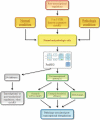Analysis of post-transcriptional regulations by a functional, integrated, and quantitative method
- PMID: 19411282
- PMCID: PMC2722765
- DOI: 10.1074/mcp.M800503-MCP200
Analysis of post-transcriptional regulations by a functional, integrated, and quantitative method
Abstract
In the past 10 years, transcriptome and proteome analyses have provided valuable data on global gene expression and cell functional networks. However, when integrated,these analyses revealed partial correlations between mRNA expression levels and protein abundance thus suggesting that post-transcriptional regulations may be in part responsible for this discrepancy. In the present work, we report the development of a functional, integrated, and quantitative method to measure post-transcriptional regulations that we named FunREG. This method enables (i) quantitative measure of post-transcriptional regulations mediated by selected 3-untranslated regions and exogenous small interfering-RNA or micro-RNAs and (ii) comparison of these regulatory processes in physiologically relevant systems (e.g. cancer versus primary untransformed cells). We applied FunREG to the study of liver cancer, and we demonstrate for the first time the differential regulatory mechanisms controlling gene expression at a post-transcriptional level in normal and tumoral hepatic cells. As an example, translation efficiency mediated by heparin-binding epidermal growth factor 3-untranslated region was increased 3-fold in liver cancer cells compared with normal hepatocytes, whereas stability of an mRNA containing a portion of Cyclin D1 3-untranslated region was increased more than 2-fold in HepG2 cells compared with normal hepatocytes. Consequently we believe that the method presented herein may become an important tool in fundamental and medical research. This approach is convenient and easy to perform, accessible to any investigator, and should be adaptable to a large number of cell type, functional and chemical screens, as well as genome scale analyses. Finally FunREG may represent a helpful tool to reconcile transcriptome and proteome data.
Figures






Similar articles
-
Targeting nuclear receptors with lentivirus-delivered small RNAs in primary human hepatocytes.Cell Physiol Biochem. 2014;33(6):2003-13. doi: 10.1159/000362976. Cell Physiol Biochem. 2014. PMID: 25012546
-
Analysis of post-transcriptional regulation using the FunREG method.Biochem Soc Trans. 2010 Dec;38(6):1608-14. doi: 10.1042/BST0381608. Biochem Soc Trans. 2010. PMID: 21118135
-
Real-time quantitative reverse transcriptase-polymerase chain reaction as a method for determining lentiviral vector titers and measuring transgene expression.Hum Gene Ther. 2003 Apr 10;14(6):497-507. doi: 10.1089/104303403764539387. Hum Gene Ther. 2003. PMID: 12718761
-
Translating the Untranslated Region.J Immunol. 2015 Oct 1;195(7):2963-71. doi: 10.4049/jimmunol.1500756. J Immunol. 2015. PMID: 26386038 Free PMC article. Review.
-
Implications of polyadenylation in health and disease.Nucleus. 2014;5(6):508-19. doi: 10.4161/nucl.36360. Epub 2014 Oct 31. Nucleus. 2014. PMID: 25484187 Free PMC article. Review.
Cited by
-
Molecular basis of differential target regulation by miR-96 and miR-182: the Glypican-3 as a model.Nucleic Acids Res. 2012 Feb;40(3):1356-65. doi: 10.1093/nar/gkr843. Epub 2011 Oct 18. Nucleic Acids Res. 2012. PMID: 22009679 Free PMC article.
-
Elucidating how the saprophytic fungus Aspergillus nidulans uses the plant polyester suberin as carbon source.BMC Genomics. 2014 Jul 21;15:613. doi: 10.1186/1471-2164-15-613. BMC Genomics. 2014. PMID: 25043916 Free PMC article.
-
Identify gene expression pattern change at transcriptional and post-transcriptional levels.Transcription. 2019 Jun;10(3):137-146. doi: 10.1080/21541264.2019.1575159. Epub 2019 Feb 5. Transcription. 2019. PMID: 30696368 Free PMC article.
-
The HOG pathway dictates the short-term translational response after hyperosmotic shock.Mol Biol Cell. 2010 Sep 1;21(17):3080-92. doi: 10.1091/mbc.E10-01-0006. Epub 2010 Jun 29. Mol Biol Cell. 2010. PMID: 20587780 Free PMC article.
-
Monitoring the spatiotemporal activities of miRNAs in small animal models using molecular imaging modalities.Int J Mol Sci. 2015 Mar 4;16(3):4947-72. doi: 10.3390/ijms16034947. Int J Mol Sci. 2015. PMID: 25749473 Free PMC article. Review.
References
-
- Gallardo K., Firnhaber C., Zuber H., Héricher D., Belghazi M., Henry C., Küster H., Thompson R. ( 2007) A combined proteome and transcriptome analysis of developing Medicago truncatula seeds: evidence for metabolic specialization of maternal and filial tissues. Mol. Cell. Proteomics 6, 2165– 2179 - PubMed
-
- Williamson A. J., Smith D. L., Blinco D., Unwin R. D., Pearson S., Wilson C., Miller C., Lancashire L., Lacaud G., Kouskoff V., Whetton A. D. ( 2008) Quantitative proteomics analysis demonstrates post-transcriptional regulation of embryonic stem cell differentiation to hematopoiesis. Mol. Cell. Proteomics 7, 459– 472 - PubMed
-
- Beyer A., Hollunder J., Nasheuer H. P., Wilhelm T. ( 2004) Post-transcriptional expression regulation in the yeast Saccharomyces cerevisiae on a genomic scale. Mol. Cell. Proteomics 3, 1083– 1092 - PubMed
-
- Minagawa H., Honda M., Miyazaki K., Tabuse Y., Teramoto R., Yamashita T., Nishino R., Takatori H., Ueda T., Kamijo K., Kaneko S. ( 2008) Comparative proteomic and transcriptomic profiling of the human hepatocellular carcinoma. Biochem. Biophys. Res. Commun. 366, 186– 192 - PubMed
Publication types
MeSH terms
Substances
LinkOut - more resources
Full Text Sources
Other Literature Sources
Research Materials
Miscellaneous

